Clive Barker's Undying Preview
Geoff Keighley talks with Clive Barker himself about EA's upcoming horror-themed FPS game.
While some game designers are lucky enough to have worked on a successful game in their careers, many more developers still find that first hit elusive. Just off the 405 freeway on the west side of Los Angeles, game designer Dell Siefert and producer Brady Bell are two likeable guys who fall into the latter category. In fact, ask Brady about the last game he worked on, and his response comes with a built-in apology: "Trespasser, but don't blame me for it," he says with a wince. Dreamworks Interactive's Trespasser ended up proving that even fancy physics can't make up for deficient gameplay, so when Bell and Siefert were given the chance to move on to a new project in January 1999, they vowed to make gameplay the foundation of the design. Luckily for these two, Steven Spielberg came to them with an idea: Let's do a first-person horror game. No doubt aware that Dreamworks was coming out with Jan DeBont's The Haunting that summer, Spielberg wanted the team to build the Resident Evil of first-person shooters. For Bell and Siefert, this was exactly the clean slate they needed.
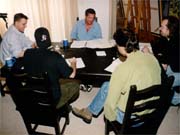
Before long, Siefert and Bell were sitting in the conference room at Dreamworks showing Spielberg a demo for a game called Undying. Over the process of a few weeks leading up to the meeting, five employees taught themselves the Unreal Editor and built levels that demonstrated things such as "spooky chairs that would fly at you inside of a manor," according to Siefert. Though the team didn't even have the license for the Unreal engine at that point, Spielberg liked what he saw and immediately gave the green light. While the team was still a skeleton crew, Bell and Siefert knew they were going to need to develop a story to tie together the horror elements. "To us a horror game is having action but also having a story around that action," says Bell.
The first stab at bringing the world of Undying to life came in the form of an imposing bald-headed hero, Count Magnus Wolfram, a master of the occult who travels to Ireland in the 1920s to rid a haunted manor of its supernatural inhabitants. The tale had all the makings of a gothic fable, complete with four dead siblings trying to come back and claim their only surviving brother.
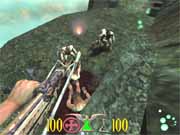
"What we really wanted to do was build a game that was Resident Evil meets Half-Life," says Siefert. While mentioning two of the biggest action games of the '90s in one breath is always a surefire way to elicit excitement, the team thought it was on the right track to building a hit because this time it was using the stable Unreal engine and concentrating on the content instead of the technology.
Things seemed to be going along as scheduled, when one day lead artist Brian Horton gave the team an opportunity it couldn't pass up. Through a friend, Horton was able to schedule a one-hour meeting with acclaimed author Clive Barker at his sprawling Beverly Hills mansion. Never ones to shy away from an opportunity, the team members soon found themselves showing the game to Barker at his wooden kitchen table. While none of them expected much to come out of the meeting besides bragging rights, in the time between ringing Barker's doorbell and leaving his house a few hours later, Undying would become Clive Barker's Undying, and Count Magnus Wolfram would breathe his last breath.
Cecil B. DeMille Orgies
Ask Clive Barker what he knows about games, and he will, without hesitation, take his left thumb and connect it with his index finger to create a firmly defined circle that represents a zero. In other words, Barker freely admits he doesn't spend his weekends playing Quake III Arena or get in a quick Red Alert 2 skirmish between penning chapters for his next book. With these facts in mind, it might seem a tad strange that the seminal author would even agree to meet a bunch of ragtag computer game developers. "I met them on the basis that if this craft is ever to be an art, it needs to aspire to the condition of all other arts: It needs to be able to tell stories that are moving and powerful and resonant," says Barker.

"Plainly there are a lot of games out there about very well-designed race cars that I have nothing to contribute to," he says, showing a bit of knowledge of the gaming space, later discovered to be a result of his brother briefly working at London-based developer Psygnosis, the company behind Lemmings and Wipeout. In fact, Barker admits to even picking up a PC game magazine from time to time. "When I look through those very thick computer game magazines, they put me in mind of Cecil B. DeMille orgies," he explains, referring to DeMille's belief that Americans were so shallow they only cared about money and sex. "In these magazines, you think something interesting is going on, but when you look at them boldly, there is absolutely nothing of interest through every single page." Asked to further explain his stance, Barker is quick to point out, "I have nothing in common with those books. There is nothing related to human truth in them."
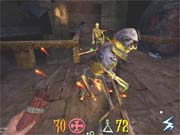
Of course the development team had no idea Barker was so adamant about the lack of reality in gaming when they agreed to meet. But they would soon find out the hard way when, at the kitchen table, Bell and Siefert pitched Clive the game's story. "Clive said to us, 'OK, there are five gaping holes in your story,'" remembers Bell.
The first point of contention was the hero, Count Magnus Wolfram. "We didn't realize how terrible our hero was until Clive walked us through the process of developing the character," Bell explains. "I just asked these guys, 'OK, so how do you relate to this guy? What piece of him?" Barker says. The team admitted there wasn't any way to relate to this big burly bald tattooed guy. Furthermore, the name had to go too. "Clive asked us, 'Do you know a count? Do you know anyone named Magnus? Have you ever met anyone named Magnus?'" Bell states rather sheepishly, now having to admit how surreal the character was both physically and nominally. "You know, I was really waiting for someone to say, 'Wait, Magnus is my uncle!'" says Barker. Such a response never came.
The good news for the team was that Barker was at least responding to their idea. "There are always problems," he says, "but the difference is that these guys were really smart and they wanted to fix them." So, with the openly gay Barker serving as a creative muse of sorts, he gave the team a task to complete before their next meeting: "I said to these guys, 'Come back here with [a hero] I can sleep with! If I can't sleep with him, don't bring him into my house.'"
Not a Ken Doll
Although Undying was already well into production when the team first met Barker, the developers were inspired by the author's interest in helping them flesh out the story and the characters. While much of the team continued down the same path after the meeting with Barker, Siefert and Bell set to work on delivering the hero Barker wanted to see in the game. The character they came up with was the plainly named Patrick Galloway - gone were the tattoos and the bald head. When Barker saw the sketch and heard the new back story, he was impressed. "Patrick is a magnificent piece of design," he says almost glowingly, as a teacher would when he's proud of his students. "There was history in this guy's face. He wasn't a Ken doll and that's important, because the whole thing will just wither on the vine if there's no truth to it."

After being impressed with the new hero, Barker agreed to lend his name to the game and also help further flesh out the story and characters. "These guys were open to doing something more - to be village storytellers," he says. However, given that the project was already well into development when Barker signed on, his involvement was limited. In fact, Barker admits he hasn't played the game yet and just recently bought a computer, which has yet to be plugged into the wall.
With Barker's name attached to the marquee, the story was finalized. "You, as Patrick Galloway, are exploring the manor house of the Covenants," says Siefert. "Jeremiah Covenant is one of your old buddies from World War I, and he has asked you to come visit his house because of supernatural occurrences." As you will find out during the early parts of the game, Jeremiah's four dead siblings are the cause of those supernatural events as they attempt to come back to the world and claim Jeremiah. Your job is to fend off these siblings and in the process explore the mansion and travel through time to strange locations such as the cursed city of Oneiros and Neolithic caves. The game is tied together by a series of 12 impressive cutscenes shown in letterbox format and rendered on the fly by an enhanced Unreal Tournament engine. The story also develops through a text journal that recaps all that you learn throughout the game.
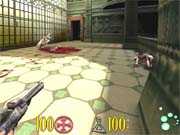
Of course, no matter how enthralling the story or how riveting the cutscenes, Siefert, Bell, and the team at Dreamworks are acutely aware that the core of the game - the gameplay - must be something wholly authored by those other than Barker. To this end, the team has spent the past 18 months building a game that has innovative gameplay elements and a series of interesting design choices that are sure to pique the interest of action gamers. Some of the interesting design decisions include the lack of in-game music and the inclusion of a two-handed combat system, whereby you'll carry weapons in one hand and spells in the other.
The Wheel of Time?
Amid so many me-too first-person shooters, one question has to be asked: What does Undying bring to the table that sets it apart from other games? In terms of horror, Siefert is quick to point out that the team is going for "creepy situations instead of boos," so don't necessarily expect to be frightened out of your chair by Undying. Instead, be prepared to be a bit uneasy with some of the graphic images. One of the most interesting features in the game is the scrye spell that serves as a window to the past. So, for instance, if you cast the spell outside of the manor on the first level, the screen will turn into a vignette with fuzzy edges and show what happened at that location in the past. (The scrye actually lights up when there is an event to see, so you don't need to endlessly cast it in every room.) While some of the events are merely for spooks, others will be integral to the story. For instance, during one part of the game, a dilapidated monastery is reflected in a pool of water. If you cast the scrye, an old and fully functional monastery is reflected in the pool, and by jumping in the water you can travel back in time.
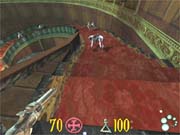
Since the scrye is used often, the team developed a two-handed combat system with an innovative approach to selecting weapons. With eight spells and eight weapons in the game - you'll only start with a fraction of these - the team wanted to move away from the idea of having to roll the mouse wheel up or down to select a certain weapon or spell. "We needed to find an efficient way to give access to spells and weapons, so we came up with selection wheels for the spells and weapons," says Siefert. You tap a key on the keyboard to bring up the wheel, and then you can move the mouse in one of eight cardinal directions to select the weapon you want. So, if you are using the double-barrel shotgun weapon and want to switch to the speargun, you simply hit the selection-wheel key on the keyboard and move your mouse in a southeastern direction. The designers hope this system will let you quickly access weapons and spells.
Speaking of the spells, the team recently cut down the number from 16 to eight - although the eight spells missing in the final product will be released as part of a free patch after the game ships. The patch will also include multiplayer, which won't make it into the shipping product. As for the spells, in addition to the innovative scrye, all the spells can be permanently upgraded by up to five levels. Some of the spell upgrades are relatively unique, such as ectoplasm, which can penetrate walls at level five. Other upgrades are more mundane, such as the skullstorm that adds one more skull to each firing as the spell level increases.
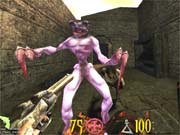
All of the spells require mana to function, and while your mana does automatically replenish over time, Siefert is trying to design puzzles that will require you to carefully plan when to cast spells. For instance, in one level a magical barrier can be destroyed by casting dispell, but it takes up a large part of your total mana. This would be all well and good, but behind the barrier are scarrows, monsters who can rise in and out of shadows and are only vulnerable to magic. As such, taking down the barrier nearly depletes your mana, which is a problem if you want to kill the scarrows. "We're trying to create interesting scenarios such as this one so you'll really have to plan out your attack," explains Siefert. In total, there are about 25 different enemies in the game - as well as the sibling bosses - although the scarrows are likely the most innovative, given their ability to actually crawl into shadows for hiding.
Candy-Colored Brilliance
Clive Barker's Undying also uses an innovative approach to music and sound design, spearheaded by composer Bill Brown (Rainbow Six and the forthcoming Anachronox) and sound designers Jack Grillo and Erik Kraber. While Brown composed synthesized music for the cutscenes and made use of a live choir, the majority of the game levels feature no looping music at all, but rather four dynamically mixed sound-effects tracks. The result is ambient music that changes to reflect your environment and subtly suggests the emotions you should feel at particular points during the game.
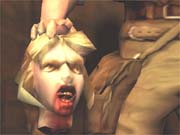
Combined, all these elements produce a game that has come a long way from where it started almost 18 months ago when Siefert and Bell first started working with Unreal tools they downloaded from the Internet. Now the team is up to 17 members, none of whom had experience with the Unreal engine before starting on the project. Clearly the team is proud of how far it's come. So is Barker, who says he views Undying as a collaborative effort. "I really think this is a business that requires collaboration and requires people to be respectful of other people's skills," he says. "I've worked as a painter, a filmmaker, a novelist, and in theater as an actor, director, and playwright, and when it comes down to it, I think game development stands in the same realm as theater when it comes to collaboration." Barker is so impressed with the collaboration that he hopes this game will lead to more Undying products: "I'm very proud of what we got," he states, "and I think the heart of this could go anywhere. If there's a second or third game, there will be a book, although whether it will come from my pen I'm not sure."
What Barker is sure of is his pride in knowing the story of Undying is better because of his involvement. When asked what he learned by working with the team, he says it was more what he was able to teach that gave him the most satisfaction. "I don't get to teach very often, but when the people you are teaching to are so smart, it sharpens you," he clarifies. "You know, I used to teach playwriting, but it was just too depressing because there were so few people making money at it. By the time you get the third suicidal telephone call, it gets you down." Luckily for Barker and those in the gaming space, the interactive market is still on the upswing. "These guys are in a successful business," he explains, "and I believe what they are doing here can become something more than the horrible bag of candy-colored garbage that are most PC games."
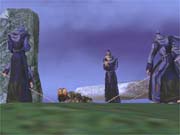
That's a strong statement coming from a guy who freely admits he's never played a PC game, but when asked to defend his position, Barker shows wisdom in his words. "If you go to a bookstore and take out the first 12 books you find," he proposes, "then go to a game store and pick the first 12 PC games you find...." He pauses to let the point sink in, and then raises his left palm and eyebrows to show there's no need to say much more than, "Case rests, m'lad!"
While Barker does show a heightened awareness of the state of PC gaming, the verdict on his first foray into the interactive space won't be rendered until Valentine's Day 2001 when Undying will arrive on the PC from Electronic Arts. There's no question that the game has an interesting premise behind it, but it still remains to be seen if Siefert and Bell can build that elusive first hit by creating compelling levels with gameplay that rivals the likes of Half-Life and No One Lives Forever. No matter what happens, it appears that this won't be Barker's last venture into interactive gaming. That's probably a good thing, given that even the most casual gamer knows the art of storytelling has so often been forgotten in pursuit of the science of a sexy-looking game.
Got a news tip or want to contact us directly? Email news@gamespot.com
Join the conversation